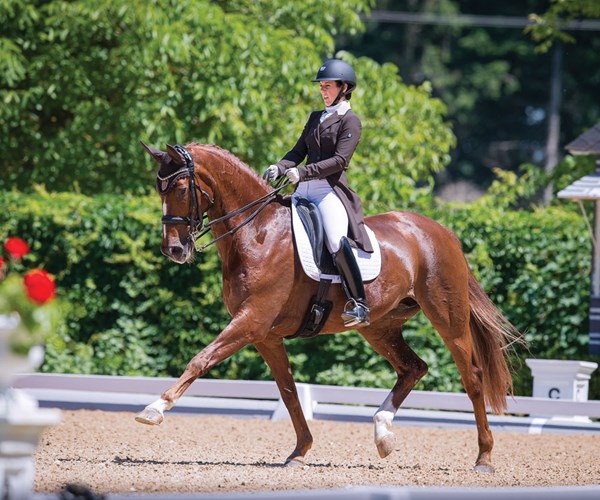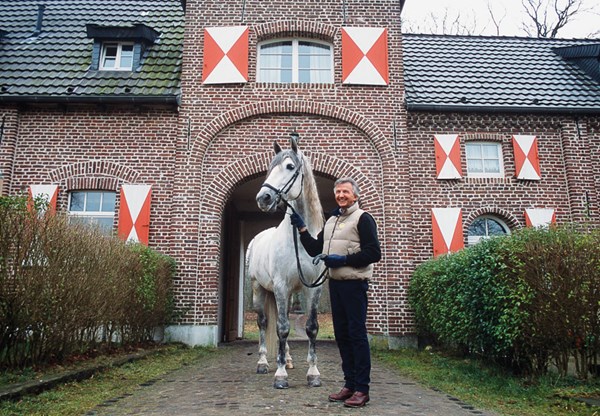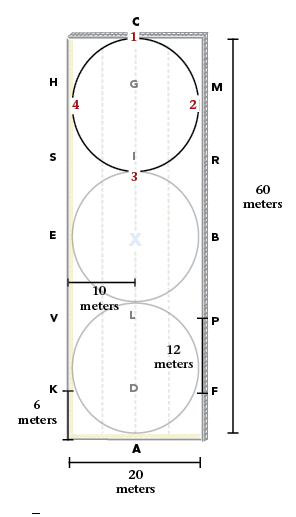Q: I feel that leaning back slightly in the sitting trot helps me sit more smoothly. Is this appropriate or will I create problems down the road? When I sit up perfectly straight in the sitting trot, the trot feels bumpier and I lose my contact. —Name withheld by request
A: Congratulations on sitting the trot! It is a wonderful step in your development as a dressage rider. The simple answer to your question is, yes, leaning back makes it easier to sit the trot. But there are stages of development for the rider, and what works right now to help you feel how to swing with the trot should continue down the path toward developing a classically correct seat, where you will sit in an ear–shoulder–hip–heel vertical alignment while continuing to sit and swing with his back.

When you are first learning to sit the trot, leaning back slightly in the saddle or “sitting on your pockets” helps you feel how the horse’s back swings and it encourages your hips to move with the horse. It is much easier to feel how the saddle is moving at the walk, trot or canter in that position. It is surprising to most riders how much their hips must move to stay in contact with the saddle. We eventually want to isolate our pelvic angle so that our seat bones are pointed straight down toward the saddle but retain the new feel we have gained of how to move with the horse’s back. Our back needs to be supple with our core engaged to sit with our seat bones pointed down toward the saddle and our upper body vertical. Prolonged use of leaning back can put your horse onto his forehand, so you must use exercises to further develop your seat and progress beyond this position to eventually sit vertical in an ear–shoulder–hip–heel alignment.
There are many reasons why learning to sit the trot feels difficult or bumpy and causes you to lose the feeling of your seat bones being “plugged into” the saddle. Your horse might not be swinging in his back. As a new dressage rider, you must learn to train your horse to use his topline and stay between your aids both laterally and longitudinally. You might be inclining your upper body too far forward, which makes it difficult to feel the motion of your horse’s back because your pelvic angle causes your seat bones to point backward, not down towards the saddle. You might be tense, locking your hip joints or stiffening your lower back. Rather, you must be toned in your core, but supple in your hips and joints. Many riders hover in the sitting trot, trying to not bounce on their horse’s back rather than accepting the movement and swinging with it. Thinking of dribbling a basketball with your hips can help with this problem.
To help a horse become supple and develop his back muscles so he can learn to swing with a rounded topline, I teach all my students how to train their horses to longe with correctly positioned side reins. Learning to longe in a constructive manner is a process where you have to make sure your horse feels comfortable every step of the way. Start with long side reins and shorten them little by little to the correct length, where the horse’s poll is the highest point and his nose is slightly in front of the vertical. Alternate between spiraling in and out of the circle as well as going more forward and coming back, increment by increment, until your horse longes safely.
I also utilize the longe to teach my riders seat lessons on well-trained longeing or vaulting horses or on their own horse when he or she is seasoned and ready. It is important to have a good longeur and a really safe horse for the lessons involving work without reins and/or stirrups. We use exercises such as:
Knee lifts (unmounted and mounted): Sitting on a chair (unmounted) with your feet directly under your knees, lift your knees just half an inch so that your feet are slightly off the floor. Can you feel your seat bones more prominently on the chair? This also engages the floor of your pelvis. Mounted and on the longe line, first slightly lift your left knee, then your right knee, maintaining the correct vertical upper-body position during the sitting trot. This helps you learn to loosen up any tight joints and also to maintain better tone in your core in order to balance and plug in your seat bones so that your back and hips move in a more supple way and swing softly with the horse’s back.
No stirrups—seat lessons on the longe line without stirrups: Work on dropping and picking up your stirrups, first walking, then trotting—both sitting and posting—then in canter. Try to maintain a vertical alignment and keep your lower leg in a correct position with your heels down, toes up.
No reins: While being longed, you can hold the bucking strap in front of the saddle at first and eventually do circles with one arm, then the other, working toward no hands holding the bucking strap and exercises such as hands on hips, “climbing a rope” with your arms and holding your arms straight up to feel the weight sink down through your seat bones.
If no safe options are available for longe lessons, there are ways to simulate some of these exercises. Ride your own horse or a safe lesson horse and do some no-stirrup work every day. Ride with one hand in a rein bridge, where you take both reins and cross them over, the right rein over to the left side of the horse’s neck and the left rein over the neck to the right. In the spot where they cross, grasp them both together in one hand so you can steer the horse with your reins and your legs. Then you are free to circle one arm, then switch arms and drop and pick up your stirrups as above. Switching between posting and sitting the trot for a few strides will also help you let go and move with your horse.
Each rider is on a personal journey to improve her own seat and position and to come closer to the classically correct seat. The quieter her seat and hands, the better harmony she will be in with her horse. The better harmony, the smaller and quieter aids she can use to get the response she wants.
Joan Williams is a USDF gold, silver and bronze medalist, a USEF “R” dressage judge and USDF Certified Instructor through Fourth Level. She trains vaulters and riders of all levels at her training facility in Watsonville, California.











